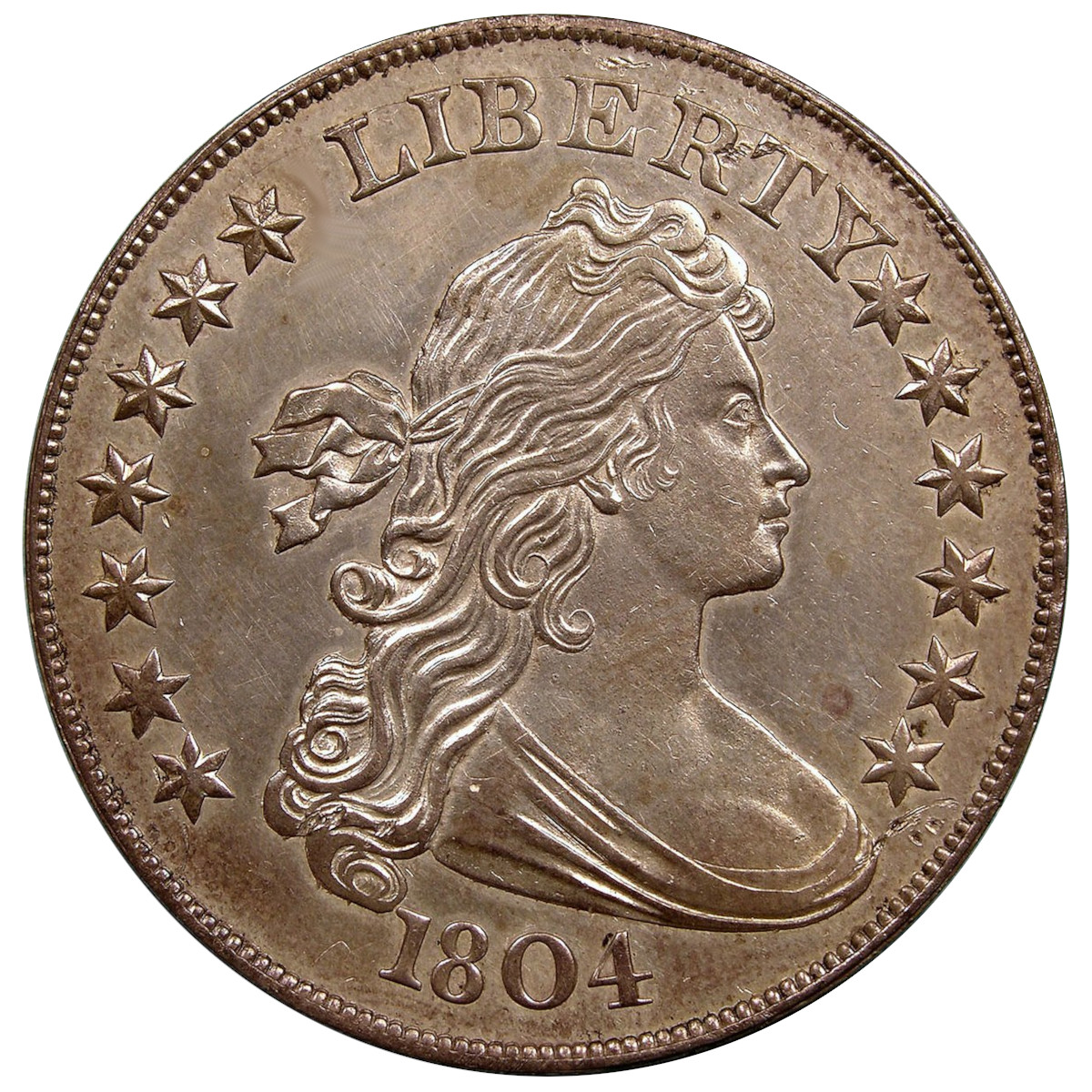
Coin Snapshot
- Weight: 26.96 grams
- Composition: 90% silver, 10% copper
- Diameter: 39-40 mm
- Thickness: 2.5 mm
- Years Minted: 1834-1835 (restrikes) despite the 1804 date
- Designed by: Robert Scot (Draped Bust Design)
- Total Coins Struck: 15 known examples (all varieties)
Brief Overview of the 1804 Dollar
The 1804 Dollar, known as the “King of American Coins,” is one of the most famous and rarest coins in U.S. numismatic history. Despite its 1804 date, no silver dollars were officially minted that year. The dollars bearing the 1804 date were produced later, primarily in the 1830s, as special diplomatic gifts by the U.S. Mint to Asian countries. These coins were struck using the older Draped Bust design, created by Chief Engraver Robert Scot, and have since become legendary among collectors due to their extreme rarity and high auction prices.
Only 15 examples of the 1804 Dollar are known to exist today, divided into three distinct classes based on their production circumstances. These few remaining coins have reached millions of dollars in value at auction, making them not only prized numismatic treasures but also symbols of American history and diplomacy.
1804 Dollar Coin Obverse Design
The obverse of the 1804 Dollar features the Draped Bust design, originally created by Robert Scot. This design showcases a classical portrait of Lady Liberty, with flowing hair and a draped bust, symbolizing the neoclassical artistic style popular in the early 19th century. Liberty is surrounded by 13 stars representing the original colonies, and the word “LIBERTY” appears prominently above her head. The date “1804” is inscribed below Liberty’s portrait, despite the fact that no such coins were struck during that year.
The Draped Bust design was widely used on U.S. silver coinage, including half dollars and silver dollars, from 1795 to 1804. The elegance and classical beauty of the obverse design continue to captivate collectors today, making it one of the most recognized and cherished coin designs in U.S. history.
1804 Dollar Coin Reverse Design
The reverse of the 1804 Dollar features a heraldic eagle design, also created by Robert Scot, based on the Great Seal of the United States. The eagle holds an olive branch in its right talon, symbolizing peace, and arrows in its left talon, representing the nation’s readiness for defense. Above the eagle’s head is a cluster of stars surrounded by clouds, and the motto “E PLURIBUS UNUM” (“Out of many, one”) appears on a banner carried by the eagle.
The inscription “UNITED STATES OF AMERICA” encircles the design along the outer edge of the reverse. The denomination “ONE D.” is displayed below the eagle. This heraldic eagle design was a standard on U.S. silver dollars of the time and has become one of the most iconic reverse designs in U.S. coinage history.
History of the 1804 Dollar
The story of the 1804 Dollar is one of intrigue, diplomacy, and error. Although the coins are dated 1804, no silver dollars were minted that year. The coins now known as 1804 Dollars were struck in the 1830s as part of special presentation sets intended for diplomatic gifts. In 1834, under the administration of President Andrew Jackson, the U.S. government decided to create these sets to be given to foreign dignitaries. The U.S. Mint mistakenly used the date 1804 on these coins, unaware that no silver dollars had been minted that year.
These 1804-dated silver dollars were produced in small numbers and given to figures such as the Sultan of Muscat and the King of Siam as part of official U.S. diplomatic missions. As time passed, these coins became incredibly valuable, with collectors and historians recognizing their rarity and historical significance. Today, only 15 examples of the 1804 Dollar are known to exist, divided into three classes:
Class I 1804 Dollars
Class I 1804 Dollars were the original coins struck in the 1830s for the diplomatic gift sets. Eight of these coins are known to exist, and they are the most valuable of the three classes due to their historical significance and connection to U.S. diplomacy. The most famous example, the **”Sultan of Muscat” 1804 Dollar**, was given as a gift to the Sultan of Muscat and sold at auction in 2013 for over $4.1 million.
Class II 1804 Dollars
Class II 1804 Dollars were restruck in the late 1850s using the original dies but with a slightly different edge design. Only one Class II 1804 Dollar is known to exist, and it is currently held in the Smithsonian Institution. These coins were likely struck as experimental pieces by Mint officials.
Class III 1804 Dollars
Class III 1804 Dollars were struck later in the 1850s or early 1860s for collectors. Six examples of Class III 1804 Dollars are known to exist. While these coins were not part of the original diplomatic gift sets, they are still highly prized by collectors due to their association with the famous 1804 Dollar series.
Rarity and Value of the 1804 Dollar
The 1804 Dollar is one of the rarest and most valuable coins in the world. Due to its limited production and its historical significance as a diplomatic gift, these coins have fetched extraordinary prices at auction. The Class I 1804 Dollars, especially those with documented provenance to foreign dignitaries, are the most valuable.
The most famous sale of an 1804 Dollar occurred in 1999, when a Class I example known as the **”King of Siam” 1804 Dollar** sold for a record $4.14 million at auction. Other examples have consistently sold for millions of dollars, cementing the 1804 Dollar’s status as the most famous and coveted U.S. coin.
Class II and Class III 1804 Dollars are also highly valuable, though they tend to sell for lower prices compared to the original Class I coins. Even so, these coins can reach prices in the hundreds of thousands or millions of dollars, depending on their condition and provenance.
Examples of Famous 1804 Dollar Sales
- Sultan of Muscat 1804 Dollar: Sold for $4.1 million in 2013, this Class I coin was originally gifted to the Sultan of Muscat by the U.S. government.
- King of Siam 1804 Dollar: Part of the King of Siam presentation set, this Class I coin sold for $4.14 million at auction in 1999.
- Dexter 1804 Dollar: A famous Class I example, this coin features a small “D” punched into the cloud on the reverse. It sold for $3.3 million in 2017.
1804 Dollar Condition and Certification
Given the extreme rarity and value of the 1804 Dollar, all known examples are carefully preserved and graded by professional numismatic services like PCGS and NGC. These coins are typically held in private collections, museums, or institutional holdings, with few examples appearing on the open market.
Certification of these coins is crucial, as their authenticity and provenance play a significant role in determining their value. Most 1804 Dollars that have been sold at auction are in high-grade condition, with many graded as Proof (PR). The large size of the coin and its limited handling has resulted in many examples being well-preserved, adding to their desirability among collectors.
Buying an 1804 Dollar
Given the extreme rarity and high value of the 1804 Dollar, it is not a coin that most collectors will have the opportunity to purchase. These coins typically only appear at high-end auctions, where they attract the attention of wealthy collectors and institutions. For those interested in purchasing an 1804 Dollar, it is essential to work with reputable auction houses or private dealers specializing in rare and historical U.S. coins.
The most famous examples of the 1804 Dollar have sold for millions of dollars, and even the more accessible Class III examples can reach six- or seven-figure prices. Collectors looking to acquire an 1804 Dollar should also consider the coin’s provenance, as this can have a significant impact on its value.
Although the 1804 Dollar is out of reach for most collectors, it remains a fascinating and important piece of U.S. numismatic history. The rarity, beauty, and historical significance of the coin make it a true “King” among American coins, and its story continues to captivate collectors and historians alike.
